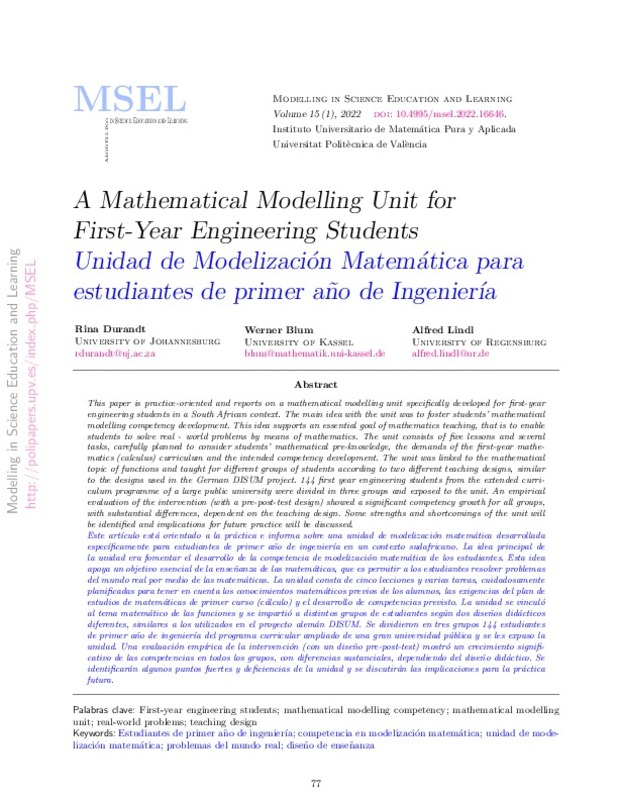Blum, W. (2011). Can modelling be taught and learnt? Some answers from empirical research. In G. Kaiser, W. Blum, R. Borromeo Ferri, & G. Stillman (Eds.), Trends in Teach¬ing and Learning of Mathematical Modelling (ICTMA 14) (pp. 15-30). Dordrecht: Springer. https://doi.org/10.1007/978-94-007-0910-2_3
Blum, W. (2015). Quality teaching of mathematical modelling: What do we know, what can we do? In S.J. Cho (Ed.), The Proceedings of the 12th International Congress on Mathematical Education - Intellectual and Attitudinal Challenges (pp. 73-96). New York: Springer. https://doi.org/10.1007/978-3-319-12688-3_9
Blum, W., & Leiß, D. (2007). How do students and teachers deal with modelling problems? In C. Haines, P. Galbraith, W. Blum, & S. Khan (Eds.), Mathematical modelling: Education, engineering and economics (pp. 222-231). Chichester: Horwood. https://doi.org/10.1533/9780857099419.5.221
[+]
Blum, W. (2011). Can modelling be taught and learnt? Some answers from empirical research. In G. Kaiser, W. Blum, R. Borromeo Ferri, & G. Stillman (Eds.), Trends in Teach¬ing and Learning of Mathematical Modelling (ICTMA 14) (pp. 15-30). Dordrecht: Springer. https://doi.org/10.1007/978-94-007-0910-2_3
Blum, W. (2015). Quality teaching of mathematical modelling: What do we know, what can we do? In S.J. Cho (Ed.), The Proceedings of the 12th International Congress on Mathematical Education - Intellectual and Attitudinal Challenges (pp. 73-96). New York: Springer. https://doi.org/10.1007/978-3-319-12688-3_9
Blum, W., & Leiß, D. (2007). How do students and teachers deal with modelling problems? In C. Haines, P. Galbraith, W. Blum, & S. Khan (Eds.), Mathematical modelling: Education, engineering and economics (pp. 222-231). Chichester: Horwood. https://doi.org/10.1533/9780857099419.5.221
Blum, W., & Schukajlow, S. (2018). Selbständiges Lernen mit Modellierungsaufgaben - Untersuchung von Lern¬umgebungen zum Modellieren im Projekt DISUM. In S. Schukajlow, & W. Blum (Eds.), Evaluierte Lernumgebungen zum Modellieren (pp. 51-72). Wiesbaden: Springer Spektrum. https://doi.org/10.1007/978-3-658-20325-2_4
Brown, J. S., Collins, A., & Duguid, P. (1989). Situated cognition and the culture of learning. Educational Researcher, 18, 32-42. https://doi.org/10.3102/0013189X018001032
De Villiers, L., & Wessels, D. (2020). Concurrent development of engineering technician and mathematical modelling competencies. In G. Stillman, G. Kaiser, & C.E. Lampen (Eds.), Mathematical Modelling Education and Sense-making (pp. 209-219). Cham: Springer. https://doi.org/10.1007/978-3-030-37673-4_19
Du Plessis, L., & Gerber, D. (2012). Academic preparedness of students: An exploratory study. The journal for transdisciplinary research in Southern Africa, 8, 81-94. https://doi.org/10.4102/td.v8i1.7
Durandt, R. (2018). A strategy for the integration of mathematical modelling into the formal education of mathematics student teachers. Doctoral dissertation, University of Johannesburg.
Durandt, R., Blum, W., & Lindl, A. (2021). How does the teaching design influence engineering students' learning of mathematical modelling? An empirical study in a South African context. In F. Leung, G. A. Stillman, G. Kaiser, & K. L. Wong (Eds.), Mathematical modelling education in East and West. International perspectives on the teaching and learning of mathematical modelling (pp. 539-549). Cham: Springer. https://doi.org/10.1007/978-3-030-66996-6_45
Haines, C., Crouch, R., & Davies, J. (2001). Understanding students' modelling skills. In J. Matos, W. Blum, K. Houston, & S. Carreira (Eds.), Modelling and Mathematics Education, ICTMA 9: Applications in Science and Technology (pp. 366-380). Chichester: Horwood. https://doi.org/10.1533/9780857099655.5.366
Herget, W., & Torres-Skoumal, M. (2007). Picture (im)perfect mathematics! In W. Blum, P.L. Galbraith, H.-W. Henn, & M. Niss (Eds.). Modelling and Applications in Mathematics Education (pp. 379-386). New York: Springer. https://doi.org/10.1007/978-0-387-29822-1_41
Hilbert, S., Stadler, M., Lindl, A., Naumann, F., & Bühner, M. (2019). Analyzing longitudinal intervention studies with linear mixed models. Testing, Psychometrics, Methodology in Applied Psychology, 26, 101-119.
Kaiser, G. (2017). The teaching and learning of mathematical modeling. In J. Cai (Ed.), Compendium for Research in Mathematics Education (pp. 267-291). Reston: NCTM.
Schau, C. (2003). Students' attitudes: The 'other' important outcomes in statistics education. In H. Pan, Q. Chen, E. Stern, & D.A. Silbersweig (Eds.), Proceedings of the Joint Statistical Meeting, (pp. 3673-3683), San Francisco, CA: American Statistical Association.
Schau, C., Stevens, J., Dauphinee, T. L., & Del Vecchio, A. (1995). The development and validation of the Survey of Attitudes toward Statistics. Educational and Psychological Measurement, 55, 868-875. https://doi.org/10.1177/0013164495055005022
Schukajlow, S., Kolter, J., & Blum, W. (2015). Scaffolding mathematical modelling with a solution plan. ZDM: The International Journal on Mathematics Education, 47(7), 1241-1254. https://doi.org/10.1007/s11858-015-0707-2
Stender, P., & Kaiser, G. (2016). Fostering modeling competencies for complex situations. In C. Hirsch, & A.R. McDuffie (Eds.), Mathematical Modeling and Modeling Mathematics (pp. 107-115). Reston: NCTM.
Stewart, J. (2016). Essential calculus. London: Brooks/Cole Cengage Learning.
Stewart, J., Redlin, L., & Watson, S. (2012). Precalculus: Mathematics for calculus. London: Brooks/Cole Cengage Learning.
Stillman, G. (2019). State of the art on modelling in mathematics education: Lines of inquiry. In G. Stillman, & J. Brown (Eds.), Lines of Inquiry of Mathematical Modelling Research in Education (pp. 1-19). Cham: Springer. https://doi.org/10.1007/978-3-030-14931-4_1
Niss, M., & Blum, W. (2020). The Teaching and Learning of Mathematical Modelling. London: Routledge. https://doi.org/10.4324/9781315189314
Plath, J., & Leiß, D. (2018). The impact of linguistic complexity on the solution of math¬ematical modelling tasks. ZDM: The International Journal on Mathematics Education, 50(1+2), 159-171. https://doi.org/10.1007/s11858-017-0897-x
Pollak, H. (1979). The interaction between mathematics and other school subjects. In: UNESCO (Ed.), New Trends in Mathematics Teaching IV (pp. 232-248). Paris: UNESCO.
Reddy, V., Winnaar, L., Juan, A., Arends, F., Harvey, J., Hannan, S., Namome, C., Sekhejane, P., & Zulu, N. (2020). TIMSS 2019: Highlights of South African grade 9 results in mathematics and science. Achievement and achievement gaps. Pretoria: Department of Basic Education.
Vorhölter, K., Krüger, A., & Wendt, L. (2019). Metacognition in mathematical modeling: An overview. In S. A. Chamberlin, & B. Sriraman (Eds.), Affect in Mathematical Modeling (pp. 29-51). Cham: Springer. https://doi.org/10.1007/978-3-030-04432-9_3
[-]








